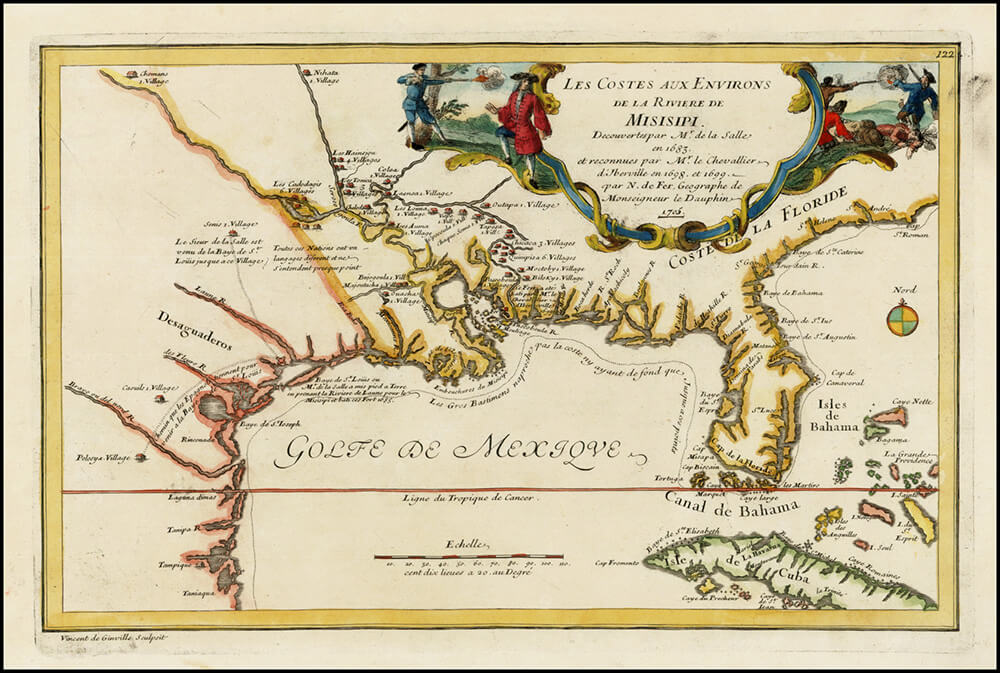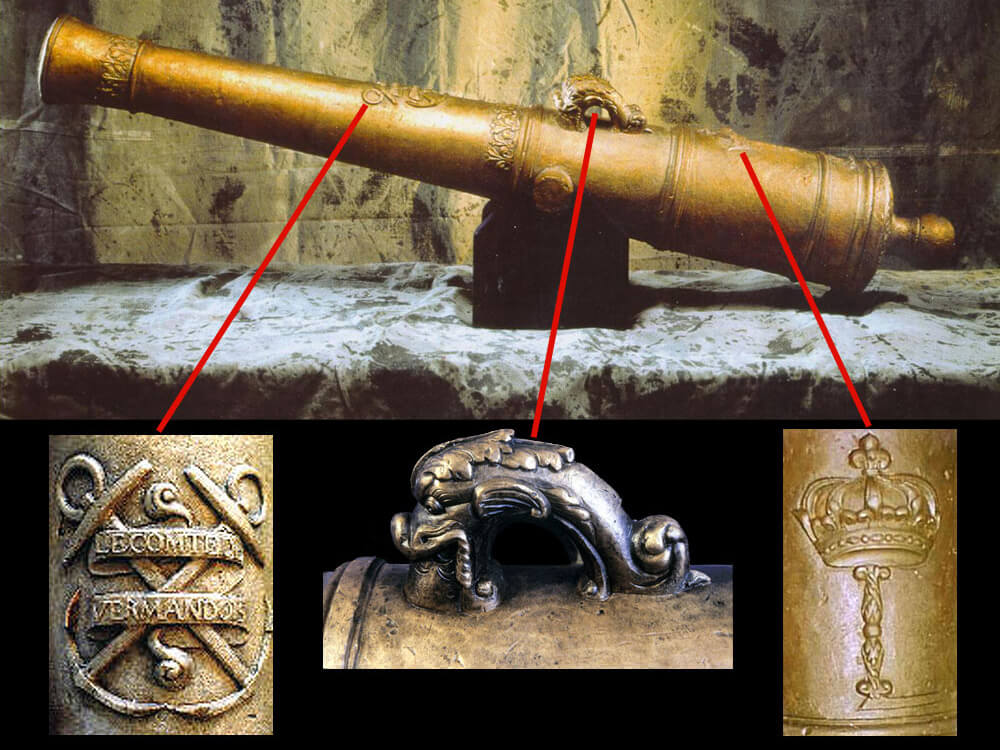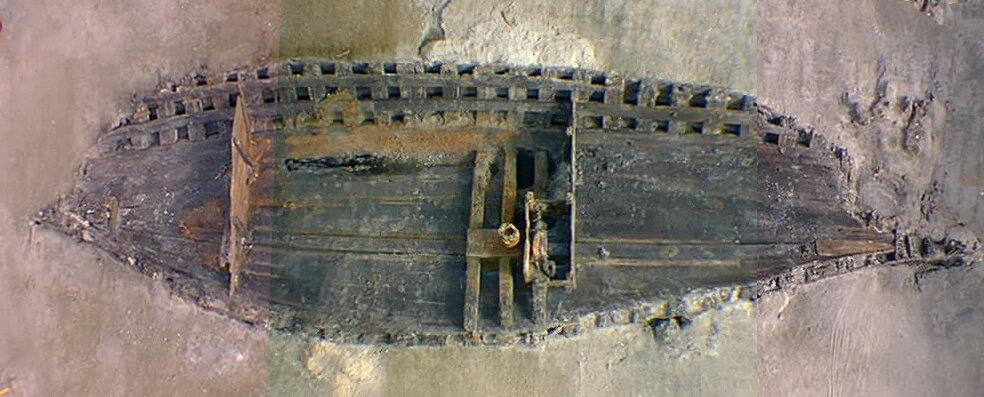Photo: Hull of La Belle (public domain)
It is said to be one of the most important archeological finds of the 20th century in North America!
Discovered in 1996 on the gulf coast of Texas, after having been submerged for more than 300 years, but remarkably well preserved, the La Belle shipwreck and her artifacts tell the extraordinary story of the final and tragic odyssey of the famous 17th-century French explorer Sieur de La Salle.
About a month ago, during a weekend road trip along the coast of Texas, about 400 miles west of the Mississippi, my husband and I had the chance to admire some of the remarkable artifacts extracted from the shipwreck of La Salle’s La Belle! And I’ll share here my experience of the various places we visited.
We had first learned about the story of La Belle shipwreck from a 1999 NOVA program, the Voyage of Doom.
It had intrigued us enough that we had decided to visit some of the seven museums in the area of Corpus Christi and Rockport which display artifacts, maps, and models of the La Belle and tell the story of her construction, her voyage to America, her loss and finally her discovery and excavation.
We definitely had a memorable experience. But even if you cannot travel to Texas, you can still learn the fascinating details of the La Belle excavations by watching this AMAZING YouTube video (54 minutes) or enjoy some of the photos below.
The Story of the La Belle and of Cavelier, Sieur de La Salle
The story of the La Belle is the story about the last expedition of René-Robert Cavelier, Sieur de La Salle, who is remembered by History for having laid claim on the Mississippi River for his King, Louis XIV in 1682. He had traveled for more than 1000 miles from the Illinois River to its mouth, in the Gulf of Mexico, and then claimed the whole Mississippi basin, roughly 1/3 of today’s continental USA.
On his last expedition, he was to establish a settlement at the mouth of the Mississippi River, to protect the French territory against possible invasions from the nearby Spanish, and possibly conquer more territory – including the Spanish silver mines in northern Mexico. But that expedition would prove to be disastrous and La Salle encountered obstacle after obstacle in his search for the Mississippi River, and ultimately died, killed by his own crew.
In July 1684, for that mission, he had embarked from La Rochelle with a small fleet of four ships, the 36-gun warship Joly, the 300-ton storeship L’Aimable, the ketch Saint François and the small barque La Belle. Only the Joly would see the coast of France again. The Saint François would be seized by pirates in the Caribbean, and both L’Aimable and La Belle would wreck on the coasts of Texas.

The story of La Belle is fascinating. This “barque longue” was actually built as a kit. Originally, La Salle intended to transport her in pieces on Le Joly and to assemble her only upon arrival to North America. For that reason, each ship frame was numbered, and these markings were actually discovered during the excavation of the ship. When La Salle decided that he preferred to assemble it in France, it was not even certain that La Belle was capable of crossing the North Atlantic, but she did make it successfully across the ocean!
La Belle was designed for coastal exploration, and for that reason had a shallow draft (around 8 feet). When La Salle first made landfall on the Texas coast, he had missed his destination. Due to various errors in maps and geography’s knowledge at the time, he was actually roughly 400 miles west of the mouth of the Mississippi River and it is on La Belle, that he would explore the coast to find the mouth of the River. But finally, after La Salle left the ship at an insecure anchorage to explore on land, and after a number of crew members died from various causes or suffered very severe dehydration, the small ship plunged stem into the reef of the barrier sand (today’s Matagorda Peninsula) in early February of 1686. Six men survived, strangled for several months on the coast until they managed to reach La Salle’s settlement, Fort Saint-Louis.
A year later, in 1687, a Spanish expedition would discover the shipwreck, describe the “broken ship” with three fleurs-de-lys on her stern and indicate her location on a map in the expedition’s journal. That would prove to be very useful information to help archeologists in their search of the shipwreck 300 years later.
An Exceptional Archeological Find
After years of unsuccessful searching, La Belle shipwreck was finally discovered in 1995, submerged under only 12 feet of water, and at the cost of more than $2 million dollars, its excavation took place in 1996. “An exceptional discovery” noted the archeology community. It was the only boat of this type to ever having been discovered, and it held roughly one million artifacts, which had been remarkably preserved by the silt of the seabed where the wreck had been laying for 300 years.
“Gradually we begin to realize that something extraordinary had happened to La Belle. Mud had encapsulated the bottom of the hull, resulting in exceptional preservation. Her cargo was largely intact, still contained in wooden barrels and boxes, many of which were exactly where La Salle and his men had loaded them three hundred years before. We now suspected that what we were going to find would be extremely significant to North American archaeology.” Excerpt from the book “From a Watery Grave”, James Bruseth and Toni Turner.
Seven Museums on the Texas Coast – The La Salle Odyssey
It was time to see for ourselves!
We knew that the Bob Bullock Texas History Museum in Austin showed some of the stories of La Belle, but we chose instead to visit some of the smaller museums in the area of Corpus Christi and Rockport, where you can see the artifacts of La Belle and relive the lives of the French sailors. We possibly saw fewer artifacts (we are not sure what can be seen in Austin) but it felt very, very special to travel the places where it had all happened and experience firsthand the bays, marshes, barrier islands, and prairies that La Salle had explored three centuries ago.
Armed with the brochure describing what could be seen at each museum (page 2 of the pdf “The La Salle Odyssey – A Series of Exhibits in Seven Museums” – see changes in some of the data below), our list of the opening hours (see below) and the custom Google map I had created, we were on our way to tour 4 of the 7 museums over 2 days.
1. Texas Maritime Museum – Rockport
We enjoyed our first stop, the Texas Maritime Museum!

At the center of the exhibit room, one can admire a very nice scale model of La Belle. One of the walls tells the history of navigation instruments from the astrolabe, the octant, and later the sextant to more modern instruments. Among the artifacts displayed are sailors’ personal belongings (like a belt and shoe buckles, a leather shoe…), 17th-century medical and navigation instruments, and even a piece of rope (surprising to see it survived 300 years in the salted water). And the reproduction of the crest of the “Comte de Vermandois”, Admiral of the Fleet (1669-1683), engraved on the canons, tells us the story of how the first recovered canon helped to first identify the shipwreck.
2. Corpus Christi Museum of Science and History
The Corpus Christi Museum of Science and History is a much larger museum, in which one room is dedicated to La Salle, his exploration, and his settlement at Fort Saint-Louis.
We did enjoy some of the things displayed, but found it somewhat overcrowded with “stuff”, and were disappointed that we could not tell which artifacts actually came from the shipwreck.
On four walls, we enjoyed seeing giant reproductions of 17th-century paintings of the ports of La Rochelle, Toulon, and Rochefort – interesting, when you know that La Belle was built in Rochefort and La Rochelle was the port La Salle left from.
We admired pewter plates from the wreck, on which you could see the maker and the owner’s marks. And we were impressed by one of the beautiful canons, with its handles in the shape of beautiful dolphins and its French insignias – the crest of Le Comte de Vermandois (already mentioned) and one of the French King Louis XIV – engraved in the cannon’s barrel.

Also very interesting was to learn more about the design of the ship with her shallow draft, how she was built as a kit, to be shipped in pieces, and even that researchers discovered she has been probably rebuilt, as her wood was both older and new.
3. Calhoun County Museum
In the little village of Port Lavaca, in an unremarkable neighborhood, our surprise was to discover a museum that looked more like a country antique store than a museum. But in three nice window displays in the middle of the room, here were beautiful artifacts, some brought by the French explorers to trade with the Indians (little bells, beads, wood combs, Jesuit brass rings, and mirrors), some used in the daily life of the sailors (elbony fork, firepot, brass pot and ladle, candle snuffer, musket piece, etc.). The lady there was much knowledgeable in answering our questions, and we learned that the number of artifacts found in that shipwreck (one million) was as much as what had been previously found in the world in shipwrecks prior to this excavation (not sure if this is accurate, but the discovery is none of the less impressive)!
We truly enjoyed this little museum!

4. Palacios City on the Sea Museum
Another little village, another little museum. First, one block away from the museum, you can see the half-size replica of La Belle in the water. Something interesting for students, I am sure, but we found it unimpressive. Inside the museum, we watched – with much pleasure – the amazing video of the excavation (available on YouTube). Unfortunately, at this time, the museum doesn’t have the temperature control equipment to be able to receive and display artifacts, so we recommend that you call ahead to learn if the museum actually has artifacts, before you head to Palacios.
And it was the end of our trip. Too bad we did not have time to visit more!
Who knows, maybe we’ll be back one day.
Hey, if you visit one of these museums, make sure to comment on your visit in the comment section below!
Opening hours of the museums:
- Corpus Christi Museum of Science and History: Tuesday to Saturday 10 am to 5 pm; Sunday 12 pm to 5 pm.
- Texas Maritime Museum: Tuesday to Saturday 10 am to 4 pm; Sunday 1 pm to 4 pm.
- Calboun County Museum: Tuesday and Wednesday 10.30am to 4.30pm; Thursday and Friday 10.30am – 5.00pm; Saturday 10.00am to 3.00pm.
- Museum of the Coastal Bend: Tuesday to Saturday 10 am to 4 pm
- Matagonda County Museum (http://www.matagordamuseum.org/): Wednesday to Saturday 1 pm to 5 pm
- La Petite Belle Homeport and City by the Sea Museum, Palacios (http://www.citybytheseamuseum.org/): Monday to Friday 10 am to 2 pm; Saturday 11 am to 3 pm
For more information on La Belle:
- See the YouTube video on the excavation. You’ll see the first canon being taken out of the water; the innovative cofferdam construction around the wreck to allow for the archeological work to take place in a drier environment; the various artifacts; the complete skeleton discovered in the bow of the boat in a coil of rope, and the analysis done to learn more about the identity and life of this unfortunate sailor; and much more.
- Visit the extensive section on La Belle on the Texas Beyond History Museum website. You may particularly appreciate the page describing the excavations with photos of the artifacts and the page about the skeleton.
- Visit the Wikipedia page on La Belle.
- Buy the tape NOVA: Voyage of Doom 1999, if you still own a VCR!
- Read the journal of Henry Joulet, one of the 6 survivors of the La Belle adventure: Journal historique du dernier voyage que feu M. de laSale fit dans le Golfe du Mexique, pour trouver l’embouchure, & le cours de la Rivière de Missicipi, nommée à present la Rivière de Saint Louis, qui traverse la LOUISIANE.

